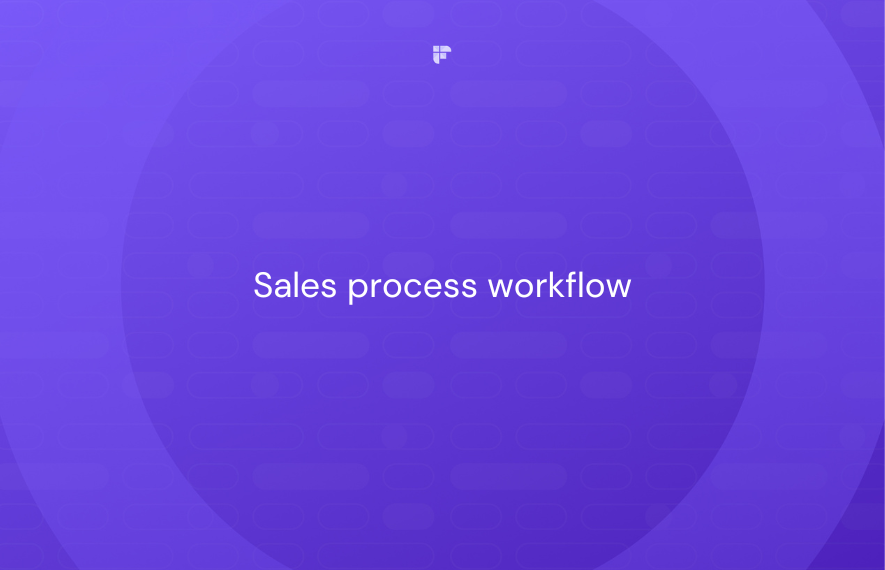Imagine this: you have a powerful sales strategy, skilled sales reps, and fantastic products or services, yet your conversion rates remain stagnant.
So, what's the problem? The absence of a structured sales workflow!
Without a clear roadmap guiding your sales process, even the most promising setup can fall short.
Sales workflow includes a repeatable set of steps your sales team can follow to move a prospect from early-stage outreach towards closing them as a customer.
A well-designed process will help your reps consistently close deals by giving them a framework to follow.
In this guide, we'll show you how to implement a sales workflow to significantly boost your conversion rates.
Let’s get started!
What is a sales workflow?

A sales workflow is a systematic sequence of steps that guides the entire sales process, from initial prospecting to closing a deal.
It outlines the specific actions, stages, and interactions that sales teams follow to move a potential customer through the buying journey effectively.
This structured framework includes various activities, such as lead qualification, nurturing, presentations, negotiations, and post-sale follow-ups.
Why build a sales process workflow?

Building a sales process workflow is essential for several reasons, each contributing to the effectiveness and success of your sales team:
1. Consistency and efficiency
A sales workflow provides a structured and consistent approach for all team members. It ensures everyone follows the same steps and processes, reducing errors and enhancing efficiency.
2. Enhances lead qualification
A sales workflow ensures that your team follows a set process to qualify these leads effectively. It helps you invest your time and energy in the leads most likely to convert into customers.
3. Improved team coordination
With a defined workflow, team members understand their roles and responsibilities, leading to better coordination. This clarity minimizes confusion and overlaps, promoting smoother collaboration.
4. Enhanced customer experience
A structured workflow allows for personalized interactions with customers. It enables tailoring sales approaches to meet individual needs, fostering better relationships, and improving customer satisfaction.
5. Better decision-making through data
A well-designed workflow incorporates data tracking at each stage. This data provides insights into what works and what needs improvement, enabling informed decision-making for refining sales strategies.
6. Training and onboarding support
A documented workflow serves as a valuable resource for training new team members. It facilitates faster onboarding by providing a clear roadmap for understanding the sales process.
7. Continuous improvement
Having a structured workflow encourages continuous improvement. It allows for periodic reviews and refinements, ensuring that the sales process stays aligned with changing market dynamics and customer needs.
Key components and stages of a sales workflow

The key components and stages of a sales workflow typically include:
1. Prospecting
Identifying and sourcing potential leads or customers.This stage involves researching and identifying individuals or businesses that might need your product or service. It could include activities like cold outreach, networking, referrals, or using marketing tools to generate leads.
2. Lead qualification
Assessing and determining the suitability and interest of leads.Once leads are gathered, this phase evaluates their likelihood to convert into customers. Criteria for qualification might include budget, authority, need, timeline (BANT), or other qualifying factors specific to your business.
3. Engagement and communication
Initiating and maintaining interactions with qualified leads.After identifying interested prospects, engaging with them is crucial. This could involve personalized communications via emails, calls, or meetings to better understand their needs and showcase how your product or service addresses those needs.
4. Sales presentations and demos
Showcasing products/services to potential customers.This step involves presenting your offering in detail, highlighting its features, benefits, and value proposition. It may include product demonstrations, customized presentations, or proposals tailored to meet the prospect's needs.
5. Negotiation and closing
Navigating negotiations and finalizing deals.Negotiating terms, pricing, and addressing objections are key aspects here. It's about reaching an agreement that satisfies both the customer's needs and your business goals. Closing involves obtaining a commitment from the prospect to move forward with the purchase.
6. Follow-up and post-sale services
Ensuring customer satisfaction and fostering long-term relationships.Post-sale, maintaining communication with the customer is crucial. It involves providing support, addressing concerns, and ensuring they're satisfied with the product or service. This phase also aims to foster loyalty and potentially generate referrals or repeat business.
Steps to create and implement a sales workflow
Creating and implementing a sales workflow involves several key steps:
1. Assess current processes
Evaluate existing sales processes to identify strengths, weaknesses, and areas for improvement. Gather feedback from sales team members to understand pain points and bottlenecks.
2. Define objectives and goals
Set clear and measurable sales objectives. Determine what you aim to achieve with the new workflow—increasing conversion rates, improving customer satisfaction, or streamlining the sales cycle.
3. Map out the sales process
Document each stage of your sales cycle—from lead generation to closing deals and post-sale services. Create a visual representation, such as a flowchart, outlining the steps involved in the sales journey.
4. Define criteria for lead qualification
Establish clear criteria for qualifying leads. This could include budget, authority, need, or timeline (BANT). Ensure alignment between sales and marketing teams on lead qualification standards.
5. Develop standardized sales tools and resources
Create templates, scripts, presentations, and any necessary tools that align with each stage of the sales process. To automate the entire process, you can use HubSpot sales workflows. The tools and resources should support your sales team in engaging with leads and closing deals effectively.

6. Train and onboard the sales team
Provide comprehensive training on the new workflow to the sales team. Ensure they understand the steps, tools, and expected outcomes. Incorporate the new workflow into onboarding programs for new hires.
7. Implement and test
Roll out the new sales workflow gradually. Monitor its implementation and gather feedback from the team during this phase. Test its effectiveness and make adjustments as necessary.
8. Regular review and optimize
Continuously review the sales workflow's performance against set goals. Collect and analyze data to identify areas that require improvement. Regularly optimize the workflow based on insights and feedback for ongoing enhancements.
9. Encourage feedback and adaptation
Foster an environment where team members can provide feedback on the workflow. Encourage adaptability and flexibility to refine processes based on changing market dynamics or customer needs.
10. Measure results and KPIs
Establish key performance indicators (KPIs) to measure the success of the new workflow. Track metrics like conversion rates, sales cycle length, customer satisfaction, and revenue generated to gauge its effectiveness.
Practical tips and strategies to improve your sales workflow

Here are some practical tips and strategies to enhance your sales process workflow:
1. Understand your customer journey
Gain a deep understanding of your customer's buying journey. Tailor your sales process to align with their needs, preferences, and pain points at each stage.
2. Leverage technology and tools
Invest in sales enablement tools and CRM systems. Automation, including sophisticated automated workflows like HubSpot Sales Workflows, can significantly streamline the sales process. They are designed to automate repetitive tasks, nurture leads, and facilitate personalized interactions with prospects.
3. Clarify and document processes
Document each step of your sales process in detail. Provide clear guidelines and resources for your team to follow, ensuring consistency and reducing errors.
4. Train and empower your team
Offer regular training sessions to keep your team updated on new techniques, tools, and changes in the sales process. Encourage autonomy and decision-making within established guidelines.
5. Optimize lead qualification criteria
Review and refine your lead qualification criteria regularly. Ensure alignment between marketing and sales teams to target high-quality leads effectively.
6. Use effective prospecting strategies
Using prospecting tools and strategies is essential. It identifies potential customers, ensuring a consistent flow of leads vital for sustained sales growth and business expansion. Here are some prospecting strategies you can use:
- Analyzing data for finding specific leads.
- Asking for referrals and networking for better leads.
- Customizing messages for different customer needs.
- Using data to predict customer interests.
- Joining industry events for new connections.
- Cold calling or emailing new leads.
- Using social media to find potential clients.
- Partnering with influencers for more exposure.
- Sharing helpful content to attract leads.
- Using SEO strategies to show up in online searches.
7. Personalize Sales Interactions
Tailor your communication and sales pitch to each prospect. Personalization enhances engagement and builds rapport, increasing the likelihood of conversion.
8. Implement a lead scoring system
Develop a lead scoring system to prioritize leads based on their likelihood to convert. This system can help your team focus on the highest potential leads, optimizing time and resources.
9. Create sales playbooks
Develop comprehensive sales playbooks outlining best practices, objections handling, and successful sales strategies. These resources serve as a guide for your team to navigate various scenarios effectively.Related: How to Close a Sales Deal: 13 Tips to Boost Sales
10. Streamline communication channels
Establish effective communication channels within the team to ensure smooth collaboration. Encourage open communication and information sharing to avoid silos and enhance teamwork.
11. Empower with sales support materials
Equip your team with updated and effective sales support materials, including case studies, testimonials, and product demos. These resources aid in building credibility and supporting sales efforts.
12. Adapt to customer feedback
Listen to customer feedback and incorporate it into your sales process. Adapt and refine strategies based on customer input to meet their needs and expectations better.
13. Focus on customer success and relationships
Prioritize customer success post-sale. Nurture relationships by offering ongoing support, addressing concerns, and maintaining a positive rapport for potential future opportunities or referrals.
Successful sales workflow examples
Here are a few successful sales workflow examples:
1. The 4-step sales workflow

2. The 6-Step Sales Workflow

3. The 7-Step Sales Workflow

You can use any of these sales workflow examples to streamline your selling process.
Improve your sales workflow with Fireflies.ai

Fireflies is an AI-powered tool designed to optimize sales process workflows by automating note-taking during client interactions and providing AI-driven insights. You can use it to improve communication effectiveness, refine sales strategies, and better understand customer needs.
Here's how Fireflies improves sales workflows:
- Automated Note-taking: Simplifies the documentation of client interactions, ensuring accurate and organized records without manual effort.
- Conversational Intelligence: Examines conversation nuances, fostering a more systematic approach to managing sales dialogues.
- Custom Notes: Create custom notes and meeting summaries to extract only the necessary information.
- Prioritization and Bottleneck Identification: Enables the team to identify potential obstacles by tracking topics, thereby streamlining the sales pipeline.
- Seamless Integration: automatically push call notes under the right contact in CRM platforms like Salesforce and HubSpot.
- Logging and Transcripts: Records calls, meetings, and notes into CRMs for easy access and management.
- Integration Flexibility: Compatible with 40+ business app including, RingCentral, Notion, Slack, Zapier, and more, ensuring adaptability.
💡 Enhance your sales workflow using Fireflies.ai!
Capture insights, automate notes, analyze conversations, refine strategies—Fireflies.ai optimizes sales workflows for efficiency, productivity, and successful outcomes.








